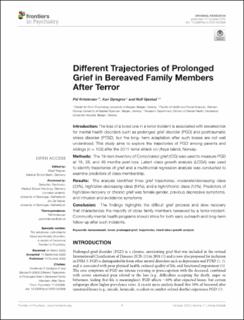| dc.contributor.author | Kristensen, Pål | |
| dc.contributor.author | Dyregrov, Kari | |
| dc.contributor.author | Gjestad, Rolf | |
| dc.date.accessioned | 2021-07-01T12:59:57Z | |
| dc.date.available | 2021-07-01T12:59:57Z | |
| dc.date.created | 2020-11-05T15:08:08Z | |
| dc.date.issued | 2020-10-14 | |
| dc.identifier.issn | 1664-0640 | |
| dc.identifier.uri | https://hdl.handle.net/11250/2762851 | |
| dc.description.abstract | Introduction: The loss of a loved one in a terror incident is associated with elevated risk for mental health disorders such as prolonged grief disorder (PGD) and posttraumatic stress disorder (PTSD), but the long- term adaptation after such losses are not well understood. This study aims to explore the trajectories of PGD among parents and siblings (n = 129) after the 2011 terror attack on Utøya Island, Norway.
Methods: The 19-item Inventory of Complicated grief (ICG) was used to measure PGD at 18, 28, and 40 months post-loss. Latent class growth analysis (LCGA) was used to identify trajectories of grief and a multinomial regression analysis was conducted to examine predictors of class membership.
Results: The analysis identified three grief trajectories; moderate/decreasing class (23%), high/slow decreasing class (64%), and a high/chronic class (13%). Predictors of high/slow recovery or chronic grief was female gender, previous depressive symptoms, and intrusion and avoidance symptoms.
Conclusion: The findings highlights the difficult grief process and slow recovery that characterizes the majority of close family members bereaved by a terror-incident. Community mental health programs should strive for both early outreach and long-term follow-up after such incidents. | en_US |
| dc.language.iso | eng | en_US |
| dc.publisher | Frontiers | en_US |
| dc.rights | Navngivelse 4.0 Internasjonal | * |
| dc.rights.uri | http://creativecommons.org/licenses/by/4.0/deed.no | * |
| dc.title | Different Trajectories of Prolonged Grief in Bereaved Family Members After Terror | en_US |
| dc.type | Journal article | en_US |
| dc.type | Peer reviewed | en_US |
| dc.description.version | publishedVersion | en_US |
| dc.rights.holder | Copyright the authors | en_US |
| dc.source.articlenumber | 545368 | en_US |
| cristin.ispublished | true | |
| cristin.fulltext | original | |
| cristin.qualitycode | 1 | |
| dc.identifier.doi | 10.3389/fpsyt.2020.545368 | |
| dc.identifier.cristin | 1845349 | |
| dc.source.journal | Frontiers in Psychiatry | en_US |
| dc.identifier.citation | Frontiers in Psychiatry. 2020, 11, 545368. | en_US |
| dc.source.volume | 11 | en_US |

